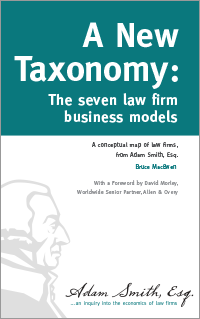A New Taxonomy provides a path-breaking analysis of the global “BigLaw” industry, identifying seven distinct species of law firm business model – their historic roots, future prospects, strengths and weaknesses, and the specific management techniques, priorities, and perspectives they require. Written with analytic rigor but an urbane and engaging style, it brings new perspective to a globally important industry, clarifying the law firm business landscape as never before.
Here’s what a few people are saying:
- “Wow! What an incredibly insightful and valuable work on taxonomy. Really, really makes sense on so many levels. I have read it twice now, and am incorporating so many of your ideas into what we need to do;” (Managing Partner, AmLaw25); and
- “My test of a good business book is simple; does it provide context that clarifies your thinking? This book does. It’s a good one. It paints the BigLaw order of battle in vivid colors on a broad canvas. It helps you see the whole battlefield, not just the skirmishes.” (from the Foreword by David Morley, Global Managing Partner of Allen & Overy
The author is a lawyer and the President of Adam Smith, Esq., an industry-leading management consultancy to law firms and the legal industry around the globe. He has written for or been quoted in:The New York Times; The Wall Street Journal; Fortune, Bloomberg; and other publications too numerous to mention, and is a sought-after speaker at law firm retreats and legal industry conferences around the world. Previously, he practiced securities law for nearly two decades in New York.
Bruce was educated at Princeton University (BA magna cum laude in economics) and at Stanford Law School (JD). A native Manhattanite, he lives on New York’s Upper West Side with his wife and their dog.
KIRKUS FEATURED REVIEW
An analytically rigorous but accessible guide to the shifting world of Big Law. MacEwen has built a strong reputation within the legal industry as an innovative thinker. He practiced law for years in New York, founded the popular website AdamSmithEsq.com and has written for numerous periodicals about legal issues. In his second book, he parses “Big Law” into its elemental, commercial parts, detailing the basic categories of law firms, including “Global Players,” “Capital Markets” and “Boutiques.” He proceeds in the spirit of biological taxonomy, linking his approach to the Linnaean method of classifying different types of natural life. He aims to use the taxonomy not only to describe these firms, but also to demonstrate the evolving nature of competition in the legal sphere: “I believe an analogy to biological classification is useful…because there’s competition within species (between individual firms who are essentially alike) as well as competition across species (between, e.g., global firms and boutiques).” For the firms themselves, understanding these classifications, and their places within them, is necessary to gauge their target audiences, and to market themselves effectively to prospective clients. The author deftly presents each of the seven types, highlighting its unique characteristics, its advantages and disadvantages, and its “managerial priorities.” He concludes with an engaging, original view about the future of law firm competition, partly inspired by Stephen Jay Gould’s “punctuated equilibria theory”: “We have enjoyed a long period of stasis, but now we may be at the start of a period of intense speciation, with new forms of life emerging—some of which will prove adaptive and survive and others of which will be rejected by the antibodies of the marketplace.” Even for the nonexpert, MacEwen’s prose is clear and mercifully free of gratuitous jargon. A sharp, concise meditation on the business of law, and by extension, an important commentary on the state of the economy as a whole.



